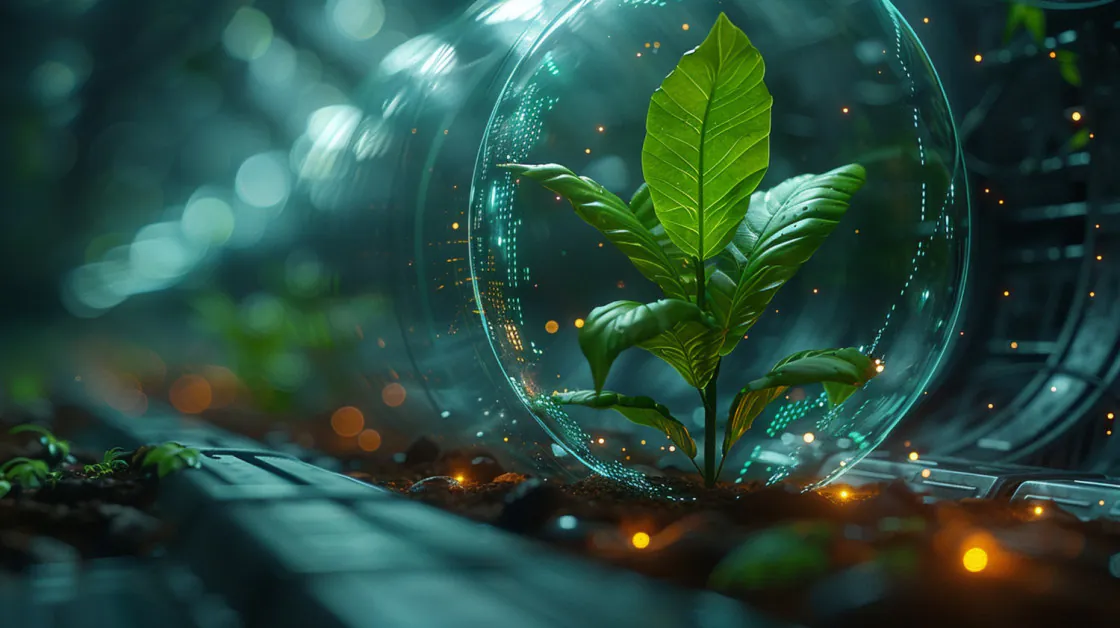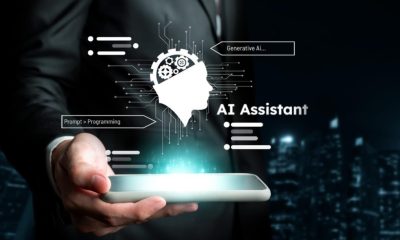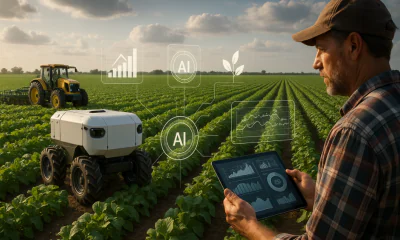Thought Leaders
Cultivating Intelligence: The Silent Tech Revolution in Farming

Agriculture is one of humanity’s oldest endeavors — so much so that it might seem there’s little left to radically change. Yet today, the agri-sector finds itself on the front lines of some of the world’s most pressing challenges: from climate change to supply chain vulnerabilities.
We often hear about AI transforming medicine or automotive, but perhaps it’s out in the fields, quite literally, where artificial intelligence is set to play one of its most pivotal roles.
Let’s explore the challenges agriculture faces today and how innovative technologies, especially AI, help uncover unexpected yet vital solutions.
Challenge #1 — Hunger and Logistics
The world’s population keeps growing, and so does the number of people to feed. Yet, the hunger problem we often hear about isn’t always due to a lack of food. According to the UN’s Food and Agriculture Organization (FAO), the world produces enough food each year to feed over 10 billion people, even though the global population is around 8 billion. Still, every ninth person, more than 735 million, suffers from chronic undernourishment.
The root cause? Logistics. We know how to grow food, but distributing it efficiently remains a massive challenge. In some regions, delivery costs are prohibitively high; in others, they’re nearly impossible. Armed conflicts, political instability, and the absence of reliable infrastructure, roads, warehouses, and cold chains make food supply complicated and costly.
So, the core issue isn’t food production itself, it’s how that food gets from farm to table.
AI technologies now offer practical tools to tackle these logistical hurdles. By analyzing vast amounts of data — from weather patterns and infrastructure status to regional market and humanitarian needs — AI optimizes delivery routes, forecasts risks, and minimizes losses along the supply chain. Innovations like antimicrobial packaging, smart containers that monitor temperature and humidity, and solar-powered cold storage are also extending the shelf life of perishables.
Challenge #2 — Food Security
Food security is a country’s ability to provide its citizens with the necessary food supplies, regardless of natural, political, or economic factors. This issue is closely tied to logistics. Today, according to various sources, dozens of countries worldwide rely on imports for their staple foods.
A simple yet telling example is the avocado, a warmth-loving crop traditionally grown in Latin America, especially Mexico, which accounts for over 30% of the world’s exports. Could countries with vastly different climates, like Canada or Finland, successfully cultivate avocados at a commercial scale? The answer lies squarely in technology, and most importantly, artificial intelligence.
AI itself won’t change the climate or “cancel winter,” but it’s a powerful tool in the hands of farmers, engineers, and biotechnologists. It helps find optimal solutions — from designing efficient greenhouses to adapting plants to local climates.
Some examples include:
- Genetic adaptation: AI systems like AlphaFold accelerate the analysis of protein structures and plant genomes. This enables scientists to identify and edit genes responsible for cold tolerance, drought resistance, or pest immunity. What once took years now happens in months or even weeks.
- Smart greenhouse systems: AI models the microclimate needed for specific crops, selecting materials with ideal insulation, and calculating optimal lighting, heating, irrigation, and ventilation. These technologies support productive greenhouse farming in extreme cold regions, even as far north as the Arctic.
Perhaps the most ambitious frontier AI opens is the creation of alternative crops capable of replacing popular foods like the widely loved avocado. The avocado story illustrates how cultural trends, like the 1990s sushi boom, where this green fruit became a staple ingredient, can turn a niche product into a global phenomenon. A similar transformation could happen with a new, AI-engineered fruit or vegetable ideally suited for cultivation in a given country. By analyzing consumption trends, taste preferences, nutritional profiles, and logistics, innovations can help develop entirely new “superfoods” biologically and from a market perspective.
Challenge #3 — Mass Production
Unlike industrial manufacturing, where output can be relatively precisely forecasted, whether it’s cars or plastic toys, agriculture remains vulnerable to a multitude of unpredictable factors. A single virus, an unexpected pest, or poor-quality fertilizers can wipe out a crop in just a few days. A disease might start in one greenhouse and quickly spread to neighboring ones; a farmer can accidentally carry the infection simply by moving between plots. These risks multiply in mass production settings, where the sheer scale makes human oversight nearly impossible.
The larger the farm, the higher the risks and the tougher the control. Fertilizers, soil, pesticides, and veterinary supplies are often sourced from multiple, sometimes foreign, suppliers, requiring complex logistical coordination and carrying risks of contamination or infection. At the same time, farmers face strict environmental and legal regulations: chemical use is tightly regulated to prevent air, water, and soil pollution. For example, the European Union has tightened pesticide regulations, and OECD countries are trending toward reducing agrochemical use by at least 30% by 2030.
In large-scale farming, manual labor and intuitive decision-making become inefficient. The volumes are simply too great to manage by hand, and the cost of errors is too high. Precise allocation of resources — fertilizers, water, chemicals — at the right place and time is essential.
How does innovation help in this matter?
- Precision agriculture & decision-making: Advanced technologies are capable of scanning soil using radar and remote sensing systems. Machine learning algorithms analyze data on soil, weather, microclimate, and pH levels to optimize resource distribution. This can reduce fertilizer and water use by 20–40%. Meteorological models further enhance this analysis by predicting weather patterns based on atmospheric movements. For example, a dust storm originating in Africa can alter the mineral content of the soil, while air masses from Europe may affect its acidity. Based on the data, accurate forecasts and agronomic recommendations are generated to support decision-making.
- Early diagnosis and prevention: AI identifies patterns in emerging problems and predicts them long before they become critical. By learning from data on supplies, treatments, and yields, AI can recommend interventions before a farmer even senses a threat. For example, Keymakr has provided annotation services for data science companies developing computer vision solutions for pest and disease detection. We helped prepare expertly labeled datasets to improve early warning systems and enable more accurate, timely interventions that protect crops at scale.
The Future of Technology: Where the River of Innovation Flows
If we imagine technological progress as a river flowing from the mountains toward the ocean, one thing becomes clear: innovation doesn’t happen in a vacuum. It flows toward areas where it can break through more easily — where there is real demand, clear business models, and economic return. Today, agriculture offers several such promising directions.
Predictive Analytics
The ability to forecast yield, disease outbreaks, climate shifts, and plant needs using big data is a necessity. AI is already helping farmers determine when and where to plant, how much to water, and when to fertilize, using weather models, satellite imagery, and sensor data. This technology is among the fastest-growing in the ag-tech space.
Vertical Farming
Once considered futuristic, vertical farming or “Babylonian towers” is now a reality. In Singapore, Japan, the UAE, and the Netherlands, dozens of vertical farms produce lettuce, greens, strawberries, and even livestock feed using multi-tier systems. The demand for such solutions is especially strong in megacities where land is limited. High-rise pig farms, biogas systems, and autonomous greenhouses enable food production at up to 10 times the yield per square meter, all while saving water and energy. For instance, in 2023, China launched the world’s first 26-story automated pig farm, where everything from feeding to waste management is fully mechanized.
Next-Gen Livestock Farming
Two key trends are reshaping livestock agriculture. The first is automation of traditional farming through smart feeders, AI-based animal health monitoring, and climate control systems. The second is the rise of alternative proteins. Interest is growing in lab-grown meat, mycoproteins (derived from fungi), and insect-based protein. These innovations are not only more sustainable but can also address a range of ethical concerns.
And finally, I’d like to mention… bees, the unique and irreplaceable pollinators. Global bee populations have been declining by approximately 35 percent each year. Given bees’ vital role in pollination, this decline poses a serious threat to the global food supply and security. According to the World Bee Project, around 75 percent of the world’s crops depend, at least in part, on bees.
I was surprised to learn that we still haven’t developed an artificial method of pollination that matches the effectiveness of bees. Brush-wielding robots, as used in China, for instance, can only mimic a small fraction of what bees accomplish naturally. The complexity and efficiency of natural pollination are a great demand and challenge for modern technology.
If I were to start a new venture today, I’d invest in beekeeping. But it’s a difficult field — bees are delicate creatures that require specific care. They often resist breeding in captivity and are vulnerable to numerous environmental threats. That’s why technologies aimed at preserving and breeding bee populations may evolve from a niche pursuit into a cornerstone of global food security.












